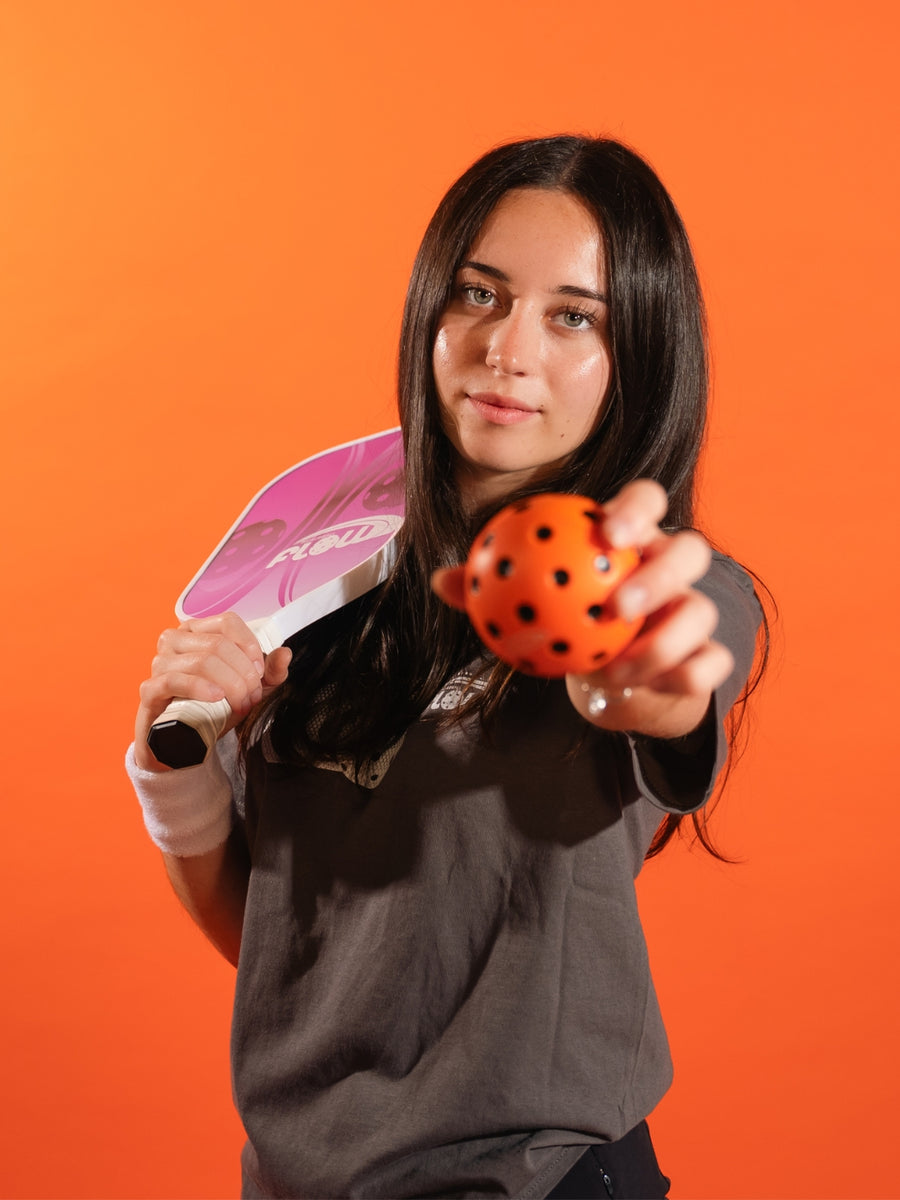Pickleball Dink Drill: Master Touch and Control at Home

Master the dink, master the game.
Whether you’re a beginner or an aspiring competitor, one shot consistently stands out as the foundation of great play: the dink. Practicing a pickleball dink drill every day helps to build consistency and control.
It might look like a soft, easy tap at the net — but in reality, it’s a high-level skill that decides points, tests patience, and creates winning opportunities. The dink is one of those shots that rewards consistency and touch more than raw power.
The good news? You don’t need a court or even a partner to practice it. With just a paddle, a ball, and a wall, you can start developing the soft hands and control that will transform your game. In this article, we’ll explore why the dink matters, how the pros use it, simple fundamentals to improve your dinking, and an easy at-home drill you can start today.
Why the Dink Matters in Pickleball
Unlike tennis, where heavy groundstrokes dominate, pickleball rewards patience and placement. The dink is a controlled shot played at the non-volley zone (or “kitchen”) line, clearing the net by just a few inches and landing softly in your opponent’s kitchen.
Here’s why it’s so important:
Neutralizes Power → A low, soft dink prevents opponents from smashing.
Forces Mistakes → Long dink rallies often end when someone loses patience or pops the ball too high.
Creates Attack Chances → By patiently moving opponents with dinks, you create openings to finish points.
Mental Edge → Dinking tests focus and discipline as much as technique.
The Mental Side of Dinking
The dink isn’t just physical — it’s mental. Staying focused in a 20-shot dink rally requires discipline. The temptation to attack too soon often leads to mistakes.
Practicing patience through dinking builds not only your pickleball game but also focus and calmness you can carry into everyday life. Many players say mastering the dink helps them enjoy pickleball more because it brings confidence and control.
“Patience wins points — watch how Ben Johns turns soft dinks into the perfect setup.”
Learn from the Pros
Professional players like Ben Johns and Anna Leigh Waters highlight how powerful the dink game can be at the highest level.
-
Ben Johns:
Keeps his paddle slightly out front to cut reaction time.
Uses soft hands and a relaxed grip to absorb pace and reset tough balls.
His biggest weapon is patience — he’s willing to dink 20–40 shots until his opponent breaks.
-
Anna Leigh Waters:
Combines quick reflexes with aggressive placement.
Uses sharp angles to move opponents out of position.
Her dinks aren’t just neutral shots — they set up opportunities for powerful counters.
👉 For everyday players, the takeaway is clear: adopt Ben’s calm consistency and layer in Anna Leigh’s smart aggression once your fundamentals are strong.
Basic Tips to Improve Your Dinking Game
You don’t need pro-level training to get better at dinking. Here are simple fundamentals every player can work on:
1. Relax Your Grip
Hold the paddle like a handshake — firm but not tight. A soft grip helps you absorb pace and avoid popping the ball too high.
2. Bend Your Knees and Stay Balanced
Stay low with small adjustment steps. Good footwork keeps you stable and helps you reach low balls.
3. Keep the Paddle in Front
Hold the paddle out in front of your body, ready to react. Short, compact swings are best — no backswing needed.
4. Aim Just Over the Net
Think “soft arc.” Keep your shot only a few inches above the net so your opponent can’t attack.
5. Control Your Follow-Through
Guide the ball instead of swinging through it. Controlled follow-through = soft, accurate shots.
6. Watch the Ball All the Way
Keep your eyes on the ball until it meets your paddle. This prevents mishits.
7. Be Patient
Stay calm in long rallies. Dinking is about outlasting your opponent — consistency wins.
Practice Your Dinks on the MiniCourt
If you want a training tool that feels close to a real court but still works at home, the MiniCourt is a game-changer. At half the size of a regulation court, it’s compact enough for a driveway, garage, or basement, yet it still gives you the feel of real rallies.
Why the MiniCourt Helps Your Dinking Game
7-Foot Kitchen Line → The MiniCourt is marked with the proper non-volley zone, so you can drill realistic dink rallies and train the discipline of keeping the ball low.
Soft Game Training → The smaller space forces you to focus on touch, control, and patience — exactly what you need to build confidence at the kitchen line.
Consistent Reps Anywhere → Instead of waiting for a court to open, you can get in hundreds of dink reps at home.
👉 Pair the MiniCourt with SilentStrike balls and you’ve got the perfect setup for a quiet, controlled at-home dink session.

“Lightweight, removable, and built for repetition. FlowShot Targets help you sharpen your soft game one shot at a time.” 🏓
Take Your Dinking Drills to the Next Level
Want your wall drill to feel even more like a real game? You can add a “net” and even mark the kitchen line.
Option 1: MiniNet Against the Wall
Our MiniNet isn’t just for driveway rallies. Swivel two of the legs and place the base flush against the wall to create a net line. This gives you a clear visual target for the right dink height.
Option 2: Flow Court Tape
Place tape on the wall at the official net height of 34 inches at the center (36 inches at the posts). This trains you to clear the net by just a few inches.
You can also tape the floor to mark the kitchen line at 7 feet from the wall. This creates a realistic practice zone for both height and depth.
With these setups, your wall drill becomes a mini pickleball court — perfect for building game-ready skills.
Why Wall Drills Are So Effective
Wall drills are a proven method across all racket sports:
Repetition Without Chasing → Continuous rallies with no wasted time.
Consistency Training → The wall never misses, forcing you to stay sharp.
Space Friendly → Practice indoors or outdoors, year-round.
Mental Discipline → Builds rhythm and patience — the mindset of a good dinker.
👉 Even five minutes a day can noticeably improve your touch and confidence at the kitchen line.
Make It Fun: Dink Challenges
Turn practice into a game with these variations:
Target Challenge → Try hitting specific FlowShot Targets on the wall.
Consistency Challenge → Count your longest rally without missing.
Time Challenge → See how many controlled dinks you can make in 60 seconds.
Spin Challenge → Experiment with slice or topspin to feel the difference.
"Every practice session will help build your dinking and overall game confidence." 🔥
Tips to Get Started
- Pick a clean, flat wall (brick, garage, basement).
- Add a chalk line or tape to simulate the net. Pickleball Flow Court Tape is a great solution.
- Start with easy forehands and backhands, focusing on rhythm.
- Use FlowShot Targets to gamify — aim at specific zones.
- Mix up shots: volleys, dinks, drives.
- Keep it short and sweet — the magic is in doing it daily.
Stories from the Court (and the Wall)
Pickleball players of all levels have their own dink stories. Some beginners say they dreaded stepping into the kitchen until wall drills helped them build soft touch and confidence. Others, even seasoned players, admit that practicing against the wall sharpened their patience more than any live match could. The wall doesn’t rush, doesn’t forgive, and — as many players say — it “never misses.”
Final Thoughts
The dink game is a reminder that pickleball isn’t just about power — it’s about control, consistency, and calm under pressure. By adding just five to ten minutes of wall or MiniCourt practice each day, you can strengthen your soft game, improve accuracy, and build confidence at the kitchen line. Small daily reps add up, and before long, your touch will feel more natural, your rallies smoother, and your game more fun.
Who We Are
At Pickleball Flow, we design products that make it easy to play anywhere — driveway, basement, or backyard. From SilentStrike balls to MiniCourts, our mission is simple: help you play more, smile more, and keep improving.








Leave a comment